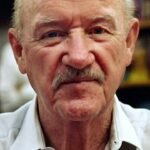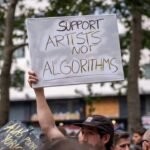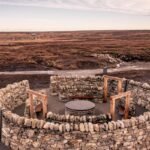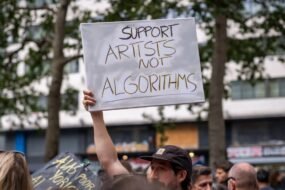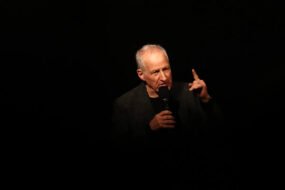
Welcome to Alta Sketchbook, your guide to Getty’s PST Art: Art & Science Collide festival.
PST Art is the largest art event in the United States. Every Friday, Alta Sketchbook will offer the most intriguing takeaways from the 800-plus artists exploring the collision of art and science through exhibitions across Southern California.
Sign up for our weekly email to have our reviews and recommendations delivered straight to your inbox. And to read our previous coverage, visit Alta Sketchbook: PST Art.
Inside the Museum of Latin American Art in Long Beach is a show with works that blink, glow, morph, and respond to reveal the durability of a movement begun in the late 1960s in great part by Brazilian artist Waldemar Cordeiro. He adopted the term arteônica—a compound of the Portuguese words for “art” and “electronic”—to characterize the socially conscious application of computer-aided expression for piercing the boundaries of concept, process, and perception in the arts. He organized a groundbreaking exhibition under that title in 1971 and died unexpectedly mid-experimentation two years later. The computer, he had argued, held the capacity to democratize both art and culture.
In an illuminating exhibition at MOLAA titled Arteônica: Art, Science, and Technology in Latin America Today—part of Getty’s PST Art: Art & Science Collide festival—works by 20 artists reference the origins of the movement and endeavor to bring its aims into the 21st century with new themes of climate vulnerability, Indigenous knowledge, and machine autonomy. It’s not just computer circuits that bring these artists and artworks together but their inheritance of a distinctive Latin American modernism shaped by political activism, 20th-century art movements, and the promises and risks of technology.
A Mulher que não ê B.B. (The woman who is not B.B.), one of Cordeiro’s earliest experiments, is a collaboration from 1971 using an IBM 360/44 computer, a stack of punch cards, and a hand-drawn grid of light and dark values to program the rendering of a photograph of an anguished Vietnamese woman, which can be seen as an image of a refugee of the Vietnam War, a critique of glamour photography (B.B. refers to Brigitte Bardot), and an icon of mechanical replication. Mexican artist Tania Candiani’s Máquina Telar (Loom machine) (2011–2012) harnesses the punch cards of a 19th-century jacquard loom to an optical tone generator. With its tall, wooden frame and long chains of linked cards the size of serving trays—ancestors of IBM cards—Candiani’s manually cranked sound loom complicates the idea of handmade while introducing another aspect of arteônica: the interplay of observer, artist, and artwork.
Using interactive tracking hardware and software, Argentine artist Mariano Sardon captured the eye movements of around 150 test subjects as they scanned portraits of ordinary men and women. Played back through the screens of Sardon’s Wall of Gazes (2017), the glowing lines of attention dart, pause, and intersect as threadlike trajectories weave a phenomenology of how a face comes into view. In Speak/Fala (2011), by Brazilian artists Rejane Cantoni and the late Leonardi Crescenti, the interactions multiply in a dialogue of observer and artwork. Step up to the microphone that faces a crowd of 40 smartphone screens and speak a word, and voice recognition software and a translation database respond with a cascade of synonyms that evolve as the software muses aloud on related words in 20 languages. It’s a demonstration of the utopian aspiration of arteônica: technology as a participant in creating meaning.
The exchange is cosmological and genealogical in Chilean artist Constanza Piña’s Khipu Electrotextile Prehispanic Computer (2018). Bundles of knotted strings called khipu encoded in their patterns and colors the administrative data of the Inca state throughout their struggle against Spanish conquest in the 16th century. Piña’s 21st-century khipu—made of twisted alpaca fiber and copper wire and knotted with both celestial and earthly data—functions as an antenna tuned to ambient electromagnetic fields that a sound generator makes audible. The sounds in Game of Life (2024), by Argentine artist Leo Nuñez, crackle from electromagnetic actuators triggered by the passing viewer. What looks like a disordered network of tangled cables responds with pinpoints of light that signal a ghostly simulation of the viewer’s presence. Interestingly, this is done with cast-off and obsolete technology—a different order of heritage.
Art and technology hybridize in Arteônica, resisting PST Art’s theme of science and art in collision. In Cordeiro’s radical optimism, arteônica was capable of being a new art form in service to society through computerization. It would give a human-centered context to the abstractions of mid-20th-century culture. The playful machines and bright projections in this exhibition honor one aspect of Cordeiro’s ambition: They are art and technology combined. But the culturally and socially transformative aspirations of arteônica are less visible and are honored mostly in the didactic wall labels staged around the gallery.
With the Arteônica exhibition, the first of its kind in the United States, the Museum of Latin American Art continues to reorient the axis of attention in the arts, not from east to west—from Europe to the Americas—but from south to north to south again, a more ancient pathway for the confluence of peoples and cultures.•
September 22, 2024–February 23, 2025
Museum of Latin American Art
628 Alamitos Ave., Long Beach
D. J.’s Must-Sees
Artists Catherine Opie, Emma Robbins, and others explore the interface between fresh water and the Pacific Ocean in Los Angeles through found objects, geological survey maps, and historical accounts while addressing social issues like access to waterways and imagining alternate possibilities for L.A.’s landscapes. Through Dec. 14, CSU Dominguez Hills University Art Gallery
Founded in Mexico City and now located in Los Angeles, the Mixografia studio garnered attention for its collaborations with artists Rufino Tamayo, Leonora Carrington, Francisco Toledo, Ed Ruscha, and others. This exhibition surveys the many innovations in art reproduction developed by the Remba family and the Mixografia studio. Through Nov. 9, Mixografia
Upcoming Shows
Oct. 17, 2024–Mar. 2, 2025, Skirball Cultural Center
Dec. 21, 2024–Aug. 1, 2025, LACMA at Charles White Elementary School Gallery
Nov. 12, San Diego Central Library Gallery
Related Coverage
DJ Waldie’s most recent book is Becoming Los Angeles: Myth, Memory, and a Sense of Place.









